Siege
An account by Albert of Aachen stated that Godfrey spent six weeks building mangenae or stone throwers, which were used to support two siege towers. [3] The number of Godfrey's men, however, was severely reduced after most of the crusaders returned home via Laodicea. [4] In the end the two assaults made on Arsuf were defeated when the garrison set the siege towers on fire. [5] Godfrey was left with no options and ended the siege
During the siege, while the Crusaders pounded the walls with catapults, the Fatamids had Gerard hung from the mast of old ship that had been lying in the city. They raised Gerard up to be in view of the attacking Crusaders. Gerard begged Godfrey to take pity on him. Godrey responded that while Gerard was the bravest of knights, but he could not call off the attack. Godfrey said that he was better for Gerard to be the sole casualty than to Arsuf to remain a danger to Christian pilgrims. Gerard then asked that his property be donated to the Holy Sepulchre, which Godfrey was Defender, instead of king. The Crusaders continued their attack. Gerard was wounded multiple times, though he managed to survive and make it back to Jerusalem.
The city rulers offered to surrender to Raymond of Saint-Gilles, but Godfrey refused. [6] Raymond even encouraged the garrison at Arsuf to hold out against Godfrey, touting his perceived weakness. [7] Within Godfrey's army, Franco I of Maasmechelen, a relative of Godfrey, is known to have died in the battle.

The Kingdom of Jerusalem, also known as the Latin Kingdom of Jerusalem, was a Crusader state established in the Southern Levant by Godfrey of Bouillon in 1099 after the First Crusade. The kingdom lasted nearly two hundred years, from 1099 until 1291 when its last remaining possession, Acre, was destroyed by the Mamluks. Its history is divided into two distinct periods.
The 1090s was a decade of the Julian Calendar which began on January 1, 1090, and ended on December 31, 1099.

Year 1099 (MXCIX) was a common year starting on Saturday of the Julian calendar.
The 1100s was a decade of the Julian Calendar which began on January 1, 1100, and ended on December 31, 1109.

Baldwin I also known as Baldwin of Boulogne, was the first count of Edessa from 1098 to 1100, and the first king of Jerusalem from 1100 to his death. Being the youngest son of Eustace II, Count of Boulogne, and Ida of Lorraine, he was destined for a church career, but he abandoned it and married a Norman noblewoman, Godehilde of Tosny. He received the County of Verdun in 1096, but he soon joined the crusader army of his brother Godfrey of Bouillon and became one of the most successful commanders of the First Crusade.
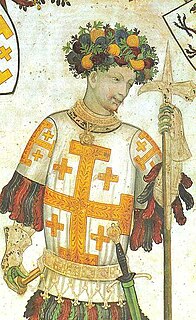
Godfrey of Bouillon was a French nobleman and one of the pre-eminent leaders of the First Crusade. He was the first ruler of the Kingdom of Jerusalem from 1099 to 1100. He apparently avoided using the title of king, choosing instead that of princeps. Older scholarship is more fond of another title, that of "advocatus of the Holy Sepulchre", a secondary title probably used by Godfrey, which is still also preferred by the Catholic Equestrian Order of the Holy Sepulchre of Jerusalem.
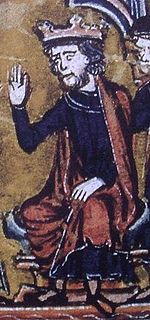
Baldwin II, also known as Baldwin of Bourcq or Bourg, was Count of Edessa from 1100 to 1118, and King of Jerusalem from 1118 until his death. He accompanied Godfrey of Bouillon, and Baldwin of Boulogne, to the Holy Land during the First Crusade. He succeeded Baldwin of Boulogne as the second count of Edessa when he left the county for Jerusalem following his brother's death. He was captured at the Battle of Harran in 1104. He was held first by Sökmen of Mardin, then by Jikirmish of Mosul, and finally by Jawali Saqawa. During his captivity, Tancred, the Crusader ruler of the Principality of Antioch, and Tancred's cousin, Richard of Salerno, governed Edessa as Baldwin's regents.

Dagobert was the first Archbishop of Pisa and the second Latin Patriarch of Jerusalem after the city was captured in the First Crusade.
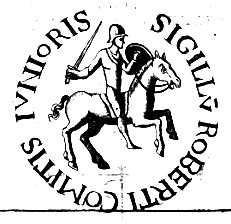
Robert II was Count of Flanders from 1093 to 1111. He became known as Robert of Jerusalem or Robert the Crusader after his exploits in the First Crusade.

The Siege of Antioch took place during the First Crusade in 1097 and 1098, on the crusade's way to Jerusalem through Syria. Two sieges took place in succession; the first siege, by the crusaders against the city held by the Seljuk Empire, lasted from 21 October 1097 to 2 June 1098. The second siege, of the crusader-held city by a Seljuk relieving army, lasted three weeks in June 1098. On that day was the Battle of Antioch, in which the crusaders defeated the relieving army led by Kerbogha. The crusaders then established the Principality of Antioch, ruled by Bohemond.
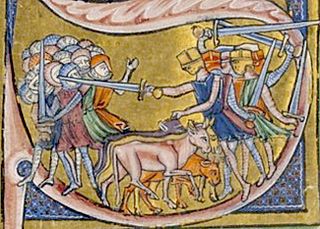
The Battle of Ascalon took place on 12 August 1099 shortly after the capture of Jerusalem, and is often considered the last action of the First Crusade. The crusader army led by Godfrey of Bouillon defeated and drove off a Fatimid army, securing the safety of Jerusalem.
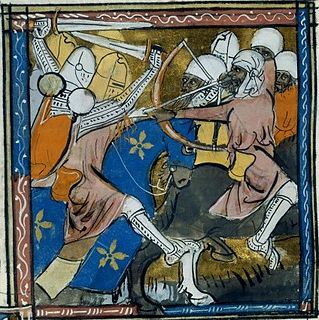
Hugh of Fauquembergues, also known as Hugh of St Omer, Hugh of Falkenberg, or Hugh of Falchenberg was Prince of Galilee from 1101 to his death. He was Lord of Fauquembergues before joining the First Crusade. Baldwin I of Jerusalem granted him Galilee after its first prince, Tancred, who was Baldwin's opponent, had voluntarily renounced it. Hugh assisted Baldwin against the Fatimids and made raids into Seljuk territories. He established the castles of Toron and Chastel Neuf. He died fighting against Toghtekin, Atabeg of Damascus.
Henry, lord of Esch, son of Fredelon of Esch. Henry was brother to Godfrey of Esch, and his family held the castle of Esch-sur-Sûre in the Ardennes. He and his brother were vassals of Henry III, Count of Luxembourg, and his brother and successor William. His step-mother was Ermengarde, Countess of Clermont, widow of Gozelon, Count of Montaigu, the founder of the family of counts of Montaigu.
Godfrey (Goeffrey), Lord of Esch and crusader, son of Fredelon of Esch. Godfrey was brother to Henry of Esch. His family held the castle of Esch-sur-Sûre in the Ardennes. He and his brother were vassals of Henry III, Count of Luxembourg, and his brother and successor William. His stepmother was Ermengarde, Countess of Clermont, widow of Gozelon, Count of Montaigu.
Raymond Pilet (1075-1120), the only child of Bernard I Pilet of Narbonne and his wife, whose name is unknown. Seigneur of Alès. Bernard was the son of Raymond II, Viscount of Narbone from 1066 to 1067. The name “pelet” refers to a fur that the nobility wore over their cuirass and coats-of-arms. Raymond distinguished himself as a great warrior during the First Crusade.
The Army of Godfrey of Bouillon was created by Godfrey, Lord of Bouillon, and Duke of Lower Lorraine, in response to the call by Pope Urban II to both liberate Jerusalem from Muslim forces and protect the Byzantine Empire from similar attacks. Godfrey and his army, one of several Frankish forces deployed during the First Crusade, was among the first to arrive in Constantinople. The army was unique in that it included among its warriors the first three kings of Jerusalem, although Godfrey preferred the title Defender of the Holy Sepulchre as he believed that the true King of Jerusalem was Christ. This article focuses on the members of the arrmy rather that its exploits which are described in detail in Godfrey’s biography as well as numerous sources listed below.
Geldemar Carpenel (Waldemar), of unknown parentage. Lord of Dargoire, Lord of Haifa (Calphas).
The siege of Aleppo by Baldwin II of Jerusalem and his allies lasted from 6 October 1124 to 25 January 1125.
The Gesta Francorum Iherusalem peregrinantium is a Latin chronicle of the First Crusade written on 1101, 1106, 1124 until 1127 by Fulcher of Chartres. He was a priest and participated in the First Crusade. He served Baldwin I of Jerusalem for many years, and wrote a chronicle of the Crusade, writing in Latin.
The Siege of Edessa in October–November 1146 marked the permanent end of the rule of the Frankish Counts of Edessa in the city on the eve of the Second Crusade. It was the second siege the city had suffered in as many years, the first siege having ended in December 1144. In 1146, Count Joscelyn II of Edessa and Baldwin of Marash recaptured the city by stealth but could not take or even properly besiege the citadel. After a brief counter-siege, Turkish governor Nūr al-Dīn took the city. The population was massacred and the walls razed. This victory was pivotal in the rise of Nūr al-Dīn and the decline of the Christian city of Edessa.










